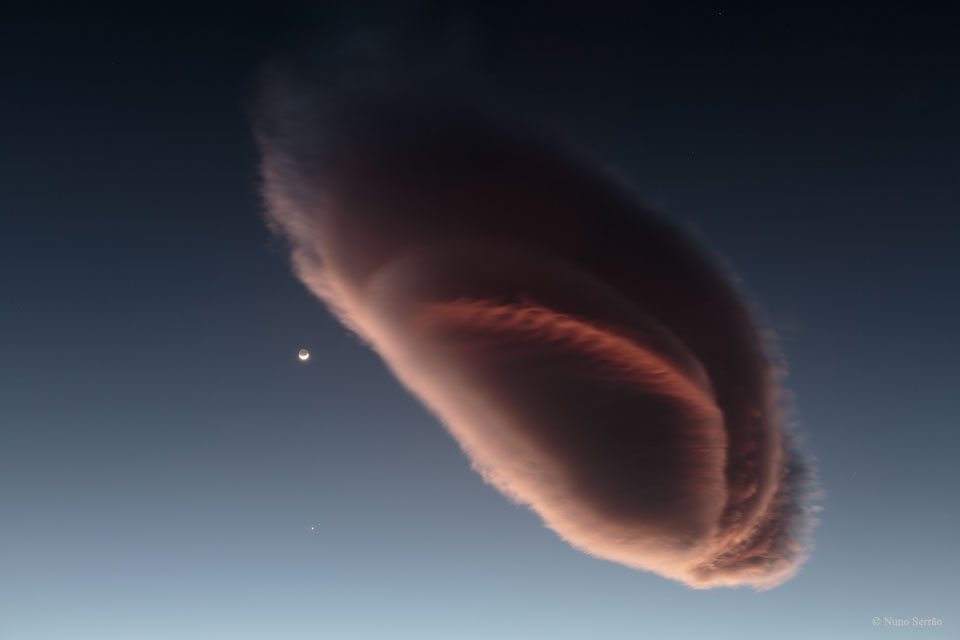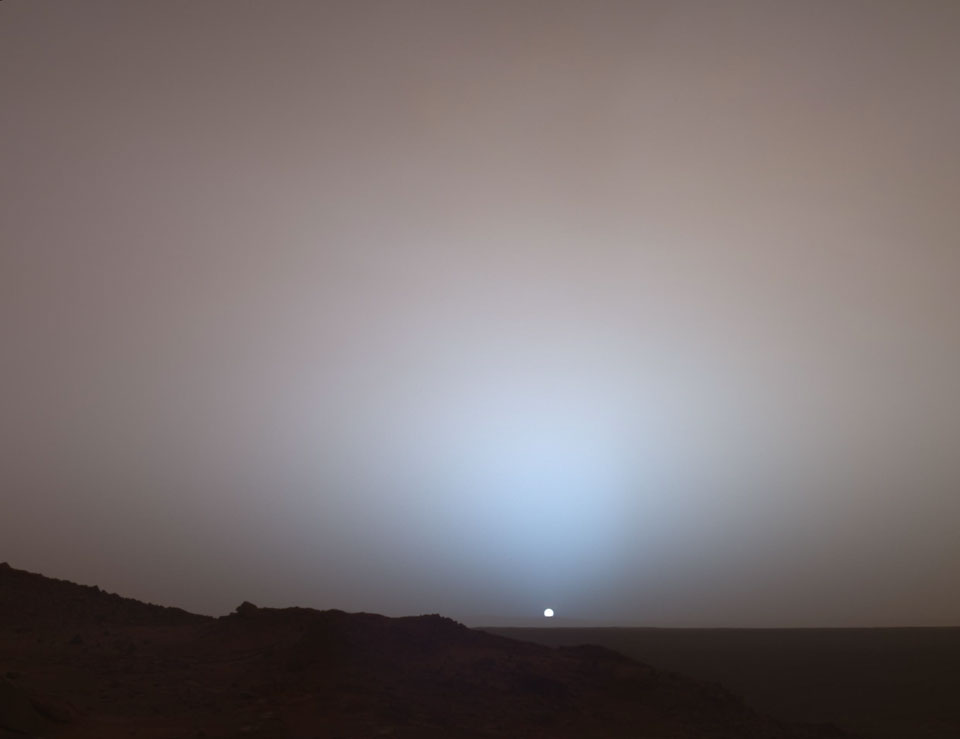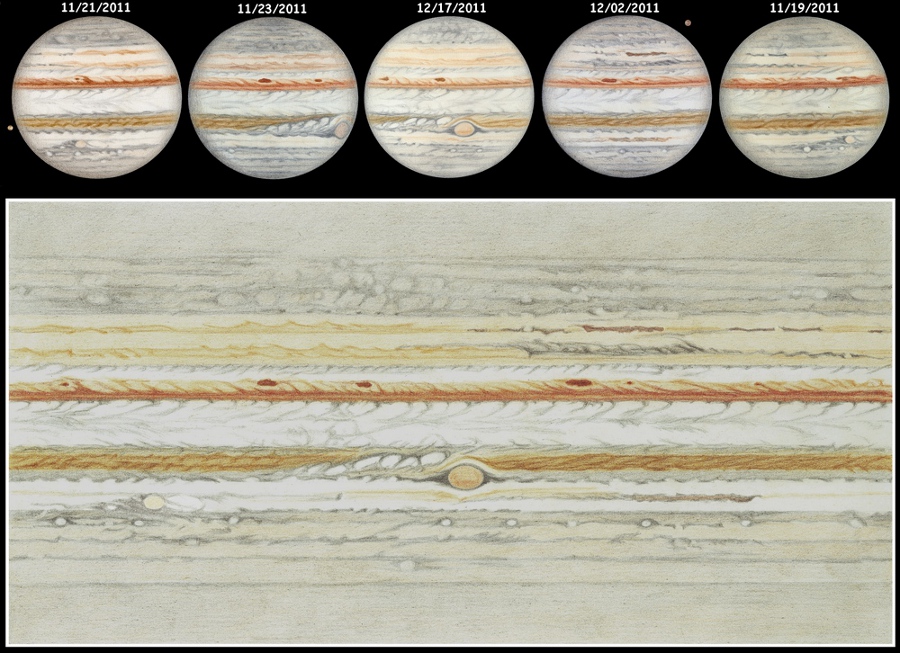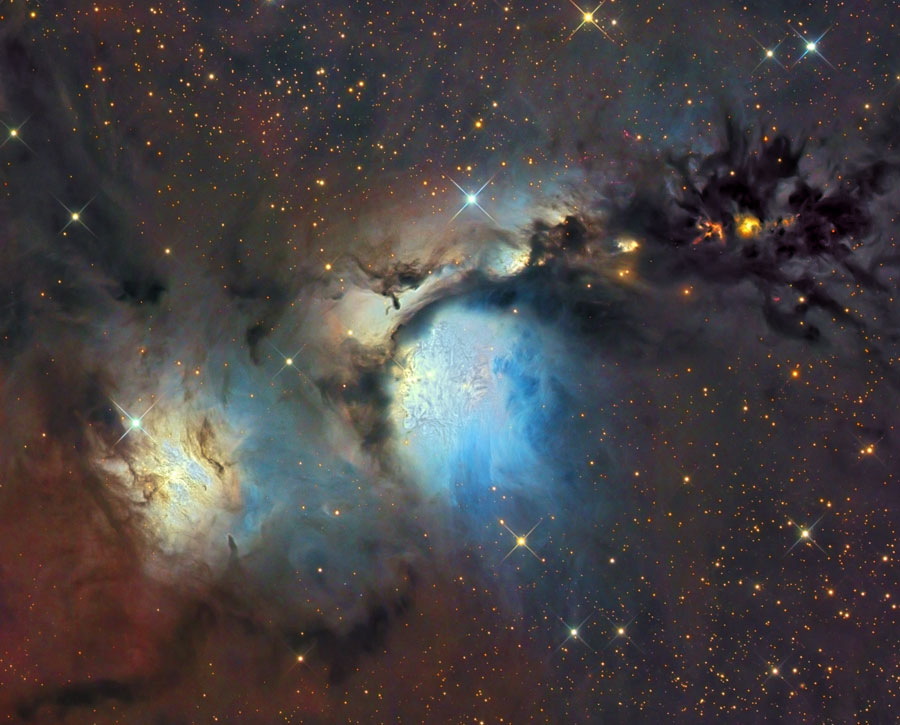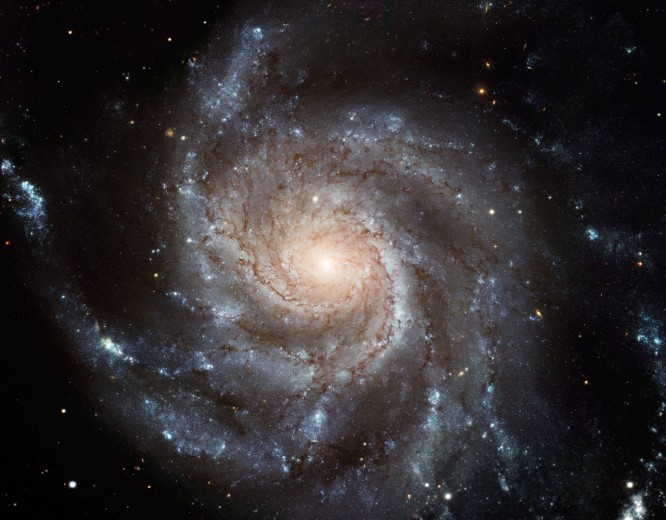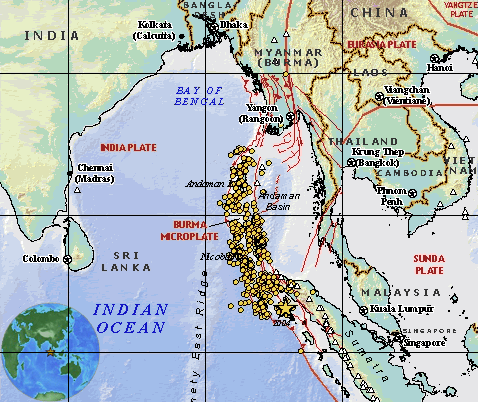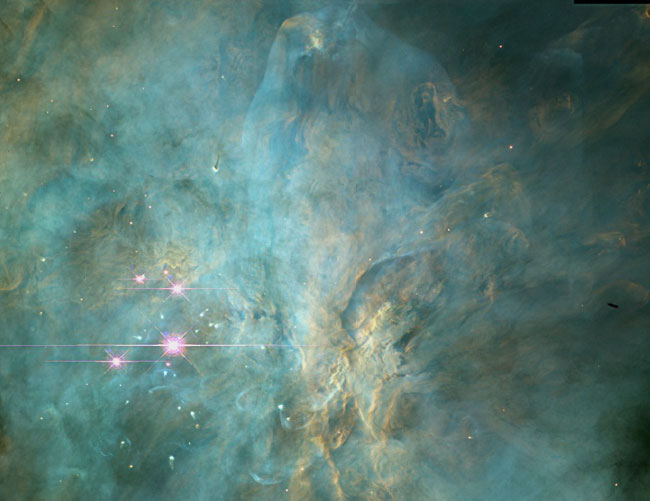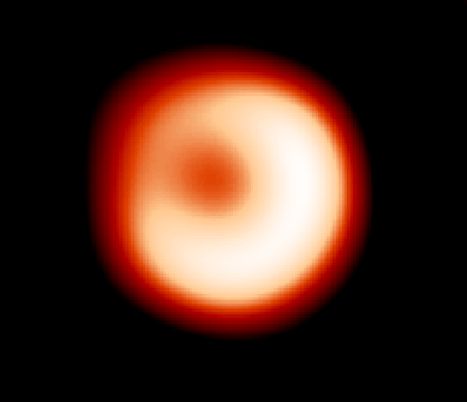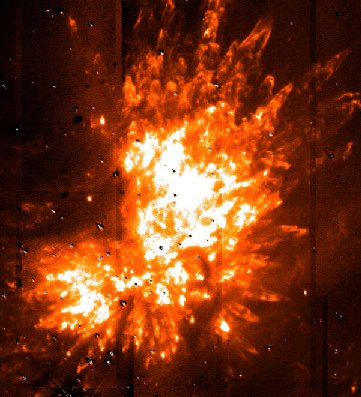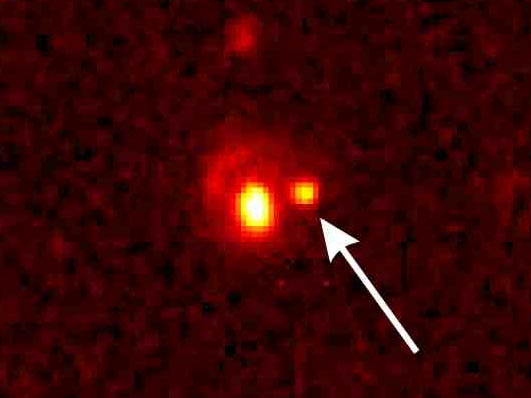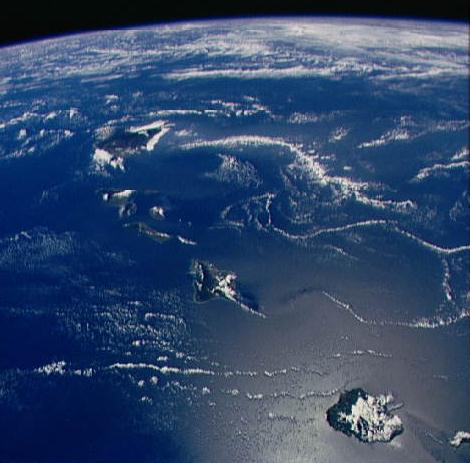| << Previous | Index | Next >> |
2015 It is not every day that such an interesting cloud photobombs your image. The original plan was to photograph a rare angular conjunction of Mars and Venus that occurred a week and a half ago, with the added bonus of a crescent Moon and the International Space Station (ISS) both passing nearby. Unfortunately, on Madeira Island, Portugal, this event was clouded out. During the next day, however, a spectacular lenticular cloud appeared before sunset, so the industrious astrophotographer quickly formulated a new plan. A close look at the resulting image reveals the Moon visible toward the left of the frame, while underneath, near the bottom, are the famous planets with Venus being the brighter. It was the unexpected lenticular cloud, though, perhaps looking like some sort of futuristic spaceship, that stole the show. The setting Sun illuminated the stationary cloud (and everything else) from the bottom, setting up an intricate pattern of shadows, layers, and brightly illuminated regions, all seen evolving in a corresponding video. Mars and Venus will next appear this close on the sky in late August, but whether any place on Earth will catch them behind such a photogenic cloud is unknown.
2014 What would it be like to see a sunset on Mars? To help find out, the robotic rover Spirit was deployed in 2005 to park and watch the Sun dip serenely below the distant lip of Gusev crater. Colors in the above image have been slightly exaggerated but would likely be apparent to a human explorer's eye. Fine martian dust particles suspended in the thin atmosphere lend the sky a reddish color, but the dust also scatters blue light in the forward direction, creating a bluish sky glow near the setting Sun. Because Mars is farther away, the Sun is less bright and only about two thirds the diameter it appears from Earth. Images like this help atmospheric scientists understand not only the atmosphere of Mars, but atmospheres across the Solar System, including our home Earth.
2013 Each day on planet Earth can have a serene beginning at sunrise as the sky gently grows bright over a golden eastern horizon. This sunrise panorama seems to show such a moment on the winter morning of February 15. In the mist, a calm, mirror-like stretch of the Miass River flows through the foreground along a frosty landscape near Chelyabinsk, Russia. But the long cloud wafting through the blue sky above is the evolving persistent train of the Chelyabinsk Meteor. The vapor trail was left by the space rock that exploded over the city only 18 minutes earlier, causing extensive damage and injuring over 1,000 people. A well-documented event, the numerous webcam and dashcam video captures from the region soon contributed to a reconstruction of the meteor's trajectory and an initial orbit determination. Preliminary findings indicate the parent meteoriod belonged to the Apollo class of Earth crossing asteroids.
2012 Five hand drawn sketches of Jupiter were used to create this beautifully detailed flat map of the ruling gas giant's turbulent cloud tops. Made with colored pencils at the eyepiece of a 16 inch diameter telescope, the original drawings are about 5 inches (12.5 cm) in diameter. The drawn planisphere map dimensions are 16x8 inches (40x20 cm). Observing on different dates in November and December of 2011, astronomical artist Fred Burgeot has relied on Jupiter's rotation to cover the planet's complete circumference. Digital animator Pascal Chauvet has also translated Burgeot's drawings into an intriguing video (vimeo), synthesizing a telescopic view of the rotating planet with a tilt and phase appropriate for the observing dates. The video includes the Galilean moons moving along their orbits, beginning with Ganymede and Io casting shadows as they glide in front of Jupiter, followed by Europa and Callisto passing behind the planet's banded disk.
2011 What's California doing in space? Drifting through the Orion Arm of the spiral Milky Way Galaxy, this cosmic cloud by chance echoes the outline of California on the west coast of the United States. Our own Sun also lies within the Milky Way's Orion Arm, only about 1,500 light-years from the California Nebula. Also known as NGC 1499, the classic emission nebula is around 100 light-years long. On many images, the most prominent glow of the California Nebula is the red light characteristic of hydrogen atoms recombining with long lost electrons, stripped away (ionized) by energetic starlight. In the above image, however, hydrogen is colored green, while sulfur is mapped to red and oxygen mapped to blue. The star most likely providing the energetic starlight that ionizes much of the nebular gas is the bright, hot, bluish Xi Persei, just outside the right image edge. A regular target for astrophotographers, the California Nebula can be spotted with a wide-field telescope under a dark sky toward the constellation of Perseus, not far from the Pleiades.
2010 An eerie blue glow and ominous columns of dark dust highlight M78 and other bright reflection nebula in the constellation of Orion. The dark filamentary dust not only absorbs light, but also reflects the light of several bright blue stars that formed recently in the nebula. Of the two reflection nebulas pictured above, the more famous nebula is M78, in the image center, while NGC 2071 can be seen to its lower left. The same type of scattering that colors the daytime sky further enhances the blue color. M78 is about five light-years across and visible through a small telescope. M78 appears above only as it was 1600 years ago, however, because that is how long it takes light to go from there to here. M78 belongs to the larger Orion Molecular Cloud Complex that contains the Great Nebula in Orion and the Horsehead Nebula.
2009 What is that streaking across the sky? A bright earthgrazing meteor. In 1972, an unusually bright meteor from space was witnessed bouncing off Earth's atmosphere, much like a skipping stone can bounce off of a calm lake. The impressive event lasted several seconds, was visible in daylight, and reportedly visible all the way from Utah, USA to Alberta, Canada. Pictured above, the fireball was photographed streaking above Teton mountains behind Jackson Lake, Wyoming, USA. The Great Daylight Fireball of 1972 was possibly the size of a small truck, and would likely have created an impressive airburst were it to have struck Earth more directly. Earthgrazing meteors are rare but are more commonly seen when the radiant of a meteor shower is just rising or setting. At that time, meteors closer to the Earth than earthgrazers would more usually strike the Earth near the horizon, while meteors further than earthgrazers would miss the Earth entirely.
2008 Comet Hale-Bopp, the Great Comet of 1997, became much brighter than any surrounding stars. It was seen even over bright city lights. Away from city lights, however, it put on quite a spectacular show. Here Comet Hale-Bopp was photographed above Val Parola Pass in the Dolomite mountains surrounding Cortina d'Ampezzo, Italy. Comet Hale-Bopp's blue ion tail, consisting of ions from the comet's nucleus, is pushed out by the solar wind. The white dust tail is composed of larger particles of dust from the nucleus driven by the pressure of sunlight, that orbit behind the comet. Observations showed that Comet Hale-Bopp's nucleus spins about once every 12 hours.
2007 Parts of Saturday's (March 3) lunar eclipse will be widely visible. For example, skywatchers in Europe, Africa, and western Asia will be able to see the entire spectacle of the Moon gliding through Earth's shadow, but in eastern North America the Moon will rise already in its total eclipse phase. Of course if you traveled to the Moon's near side, you could see the same event as a solar eclipse, with the disk of our fair planet Earth completely blocking out the Sun. For a moon-based observer's view, graphic artist Hana Gartstein (Haifa, Israel) offers this composite illustration. In the cropped version of her picture, an Apollo 17 image of Earth is surrounded with a red-tinted haze as sunlight streams through the planet's dusty atmosphere. Earth's night side remains faintly visible, still illuminated by the dark, reddened Moon, but the disk of the Earth would appear almost four times the size of the Sun's disk, so the faint corona surrounding the Sun would be largely obscured. At the upper left, the Sun itself is just disappearing behind the Earth's limb.
2006
2005 December's 9.0 earthquake has likely shortened Earth's day by about three microseconds and may also have tweaked Earth's rotational wobble. The megathrust earthquake occurred as the Indian tectonic plate slid further beneath the Burma tectonic plate. The earthquake was the fourth most powerful since the year 1900 and triggered tsunamis that tragically killed over 250,000 people in nearby coastal regions. In the above map, the yellow star indicates the location of the main earthquake, while circles show the locations of large aftershocks. The Sumatra-Andaman Islands earthquake's effect on the Earth's rotation was sudden but much smaller than the accumulated effects of other surface events such as an El Nino.
2004 Ten thousand years ago, before the dawn of recorded human history, a new light must suddenly have appeared in the night sky and faded after a few weeks. Today we know this light was an exploding star and record the colorful expanding cloud as the Veil Nebula. Pictured above is the west end of the Veil Nebula known technically as NGC 6960 but less formally as the Witch's Broom Nebula. The rampaging gas gains its colors by impacting and exciting existing nearby gas. The supernova remnant lies about 1400 light-years away towards the constellation of Cygnus. This Witch's Broom actually spans over three times the angular size of the full Moon. The bright star 52 Cygnus is visible with the unaided eye from a dark location but unrelated to the ancient supernova.
2003 Start with the constellation of Orion. Near Orion's belt is a fuzzy area known as the Great Nebula of Orion or M42. In this nebula is a bright star cluster known as the Trapezium, shown above. New stellar systems are forming there in gigantic globs of gas and dust known as Proplyds. Looking closely at the above picture also reveals that gas and dust surrounding some of the dimmer stars appears to form structures that point away from the brighter stars. The above false color image was made by combining several exposures from the orbiting Hubble Space Telescope.
2002 While searching the skies above 18th century France for comets, astronomer Charles Messier diligently recorded this object as number 27 on his list of things which are definitely not comets. So what is it? Well, 20th century astronomers would classify it as a Planetary Nebula ... but it's not a planet either, even though it may appear round and planet-like in a small telescope. Messier 27 (M27) is now known to be an excellent example of a gaseous emission nebula created as a sun-like star runs out of nuclear fuel in its core. The nebula forms as the star's outer layers are expelled into space, with a visible glow generated by atoms excited by the dying star's intense but invisible ultraviolet light. Known by the popular name of the Dumbbell Nebula, the beautifully symmetric interstellar gas cloud is about 1,200 light-years away in the constellation Vulpecula. This gorgeous synthetic color picture of M27 was produced during testing of one of the European Southern Observatory's Very Large Telescopes.
2001 You'd need a really big cup of coffee with this doughnut ... because the hole in the middle is about a billion kilometers across. Centered on the Sun, a circle that size would lie between the orbits of Mars and Jupiter. In fact, this doughnut is known to surround a massive newborn star cataloged as LkHa 101 which lies in the constellation Perseus. Imaged in infrared light, the tantalizing torus-shaped cloud of gas and dust is slightly tilted to our view. The cloud's material may well be the ingredients for the formation of a distant solar system. A bright source of ultraviolet light, the hot young star itself is much fainter in the infrared and so not visible in this picture. Still, the star's presence is indicated as its intense stellar wind and radiation has apparently carved out the doughnut's hole. This premier close-up of a stellar system in formation was accomplished by adapting a powerful observational technique called interferometry to planet Earth's largest single mirror telescope, the 10 meter Keck.
2000 A dusty bright nebula contrasts dramatically with a dusty dark nebula in this Hubble Space Telescope image recorded shortly after December's orbital servicing mission. The nebula, cataloged as NGC 1999, is a reflection nebula, which shines by reflecting light from a nearby star. Unlike emission nebulae, whose reddish glow comes from excited atoms of gas, reflection nebulae have a bluish cast as their interstellar dust grains preferentially reflect blue starlight. While perhaps the most famous reflection nebulae surround the bright young stars of the Pleiades star cluster, NGC 1999's stellar illumination is provided by the embedded variable star V380 Orionis, seen here just left of center. Extending right of center, the ominous dark nebula is actually a condensation of cold molecular gas and dust so thick and dense that it blocks light. From our perspective it lies in front of the bright nebula, silhouetted against the ghostly nebular glow. New stars will likely form within the dark cloud, called a Bok globule, as self-gravity continues to compress its dense gas and dust. Reflection nebula NGC 1999 lies about 1500 light-years away in the constellation Orion, just south of Orion's well known emission nebula, M42.
1999 The most active part of the Orion Nebular Cloud Complex is an area known as the Kleinmann-Low Nebula. There, a cluster of young and forming stars is embedded in a molecular cloud filled with dust. In visible light, the dark dust blocks much of Orion KL's light, but in the infrared light of the above photograph, the area seems literally to explode. Hot stellar winds flowing off massive young stars in Orion KL region permeate and heat surrounding gas, causing finger-like intrusions. Near the center of Orion KL is IRc2, a particularly active star estimated to have over 30 times the mass of our Sun. Radio telescopes have recently detected unusual emission from water molecules - maser radiation from the Kleinmann-Low Nebula.
1998 In a meeting in California two weeks ago, unpublished results were presented indicating that most of the energy in our universe is not in stars or galaxies but is tied to space itself. In the language of cosmologists, a large cosmological constant is directly implied by new distant supernovae observations. Suggestions of a cosmological constant (lambda) are not new -- they have existed since the advent of modern relativistic cosmology. Such claims are not usually popular with astronomers, though, because lambda is so unlike known universe components, because lambda's value appears limited by observations, and because less-strange cosmologies without lambda have historically done well in explaining the data. Therefore most lamdba claims do not make the News Summary in a prestigious journal like Science. What is noteworthy here is the seemingly direct and reliable method of the observations, and the good reputations of the scientists conducting the investigation. The above picture of a supernova at redshift 0.5 in a spiral galaxy, was taken by this collaboration. However, two teams of scientists are independently studying distant supernovae, and the last official word from the other team was a result consistent with no cosmological constant, reported just two months ago. Extraordinary claims require extraordinary evidence, and so cosmologists the world over eagerly await peer-reviewed results, further details, and more data.
1997 Aloha! With the graceful arc of the Earth's limb in the background, the entire Hawaiian Island archipelago is visible in this stunning photo taken by the astronauts onboard the shuttle Discovery in October of 1988. Along with popular beaches and tropical resorts, these volcanic islands offer extreme elevations with dark, dry, cloudless skies. Consequently they have also become popular sites for sophisticated ground based telescopes. The peak of Mauna Kea, on the Big Island (upper left), boasts an impressive array of astronomical instruments including the Keck, the Canada-France-Hawaii Telescope, the NASA IRTF, the JCMT and UKIRT, and the Gemini Telescope Project. The dormant volcanic cone of Haleakala on Maui (just below the Big Island) is home to the Air Force Maui Optical Station and the Mees Solar Observatory. Mahalo nui loa!
1996 Orbiting 1,075 miles above the Earth, a 250 foot wide, inflated, reinforced nylon "wheel" was conceived in the early 1950s to function as a navigational aid, meteorological station, military platform, and way station for space exploration by rocket pioneer Wernher von Braun. The wheel shaped station could be easily rotated creating artificial gravity so that the astronauts would not suffer the effects of prolonged weightlessness. Von Braun and his team favored building a permanently occupied Earth orbiting space station from which to stage a lunar exploration program. But in the 1960s NASA adopted the Apollo Program, which called for astronauts to transfer to a lunar landing vehicle after achieving lunar orbit, bypassing the construction of von Braun's wheel.
| << Previous | Index | Next >> |
